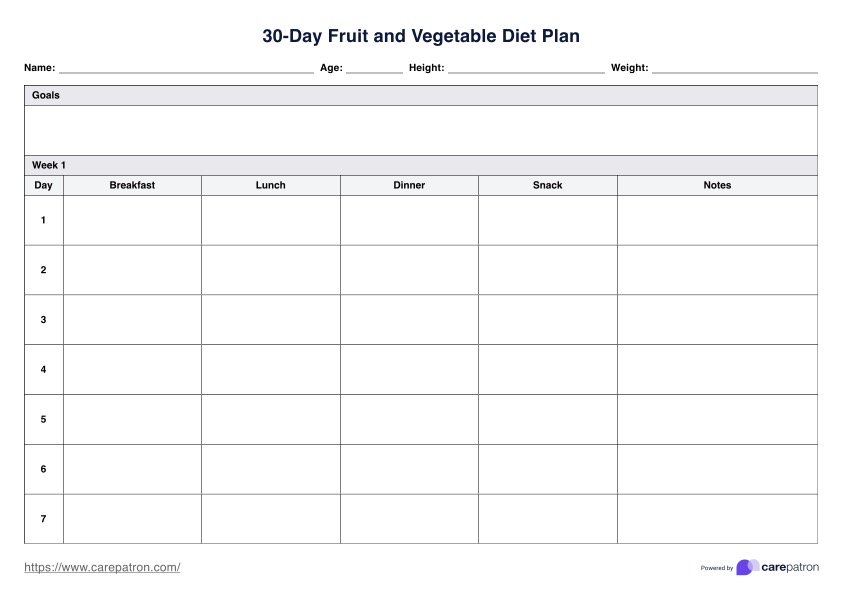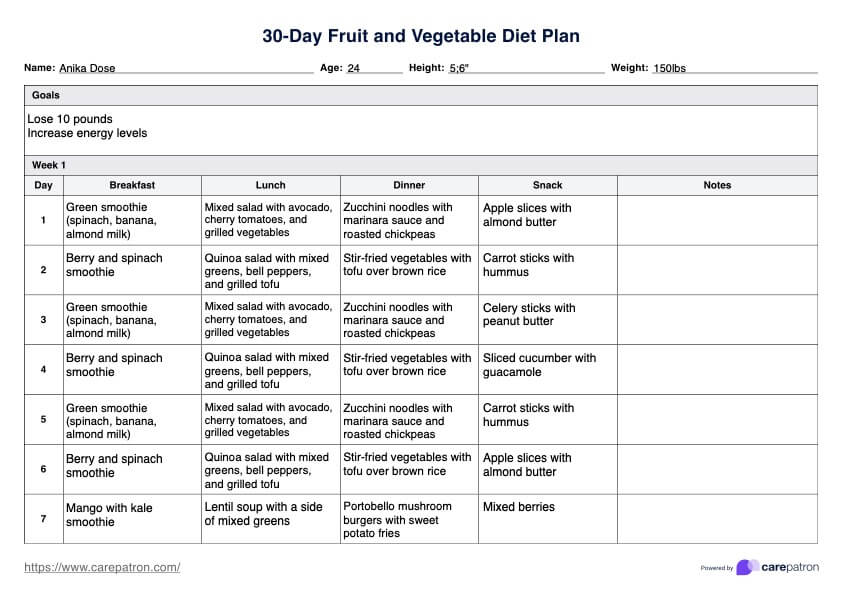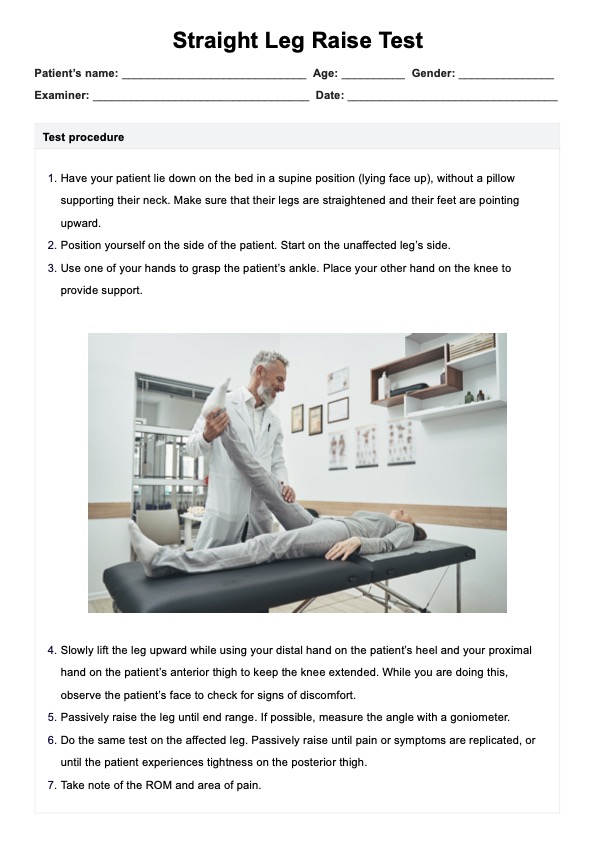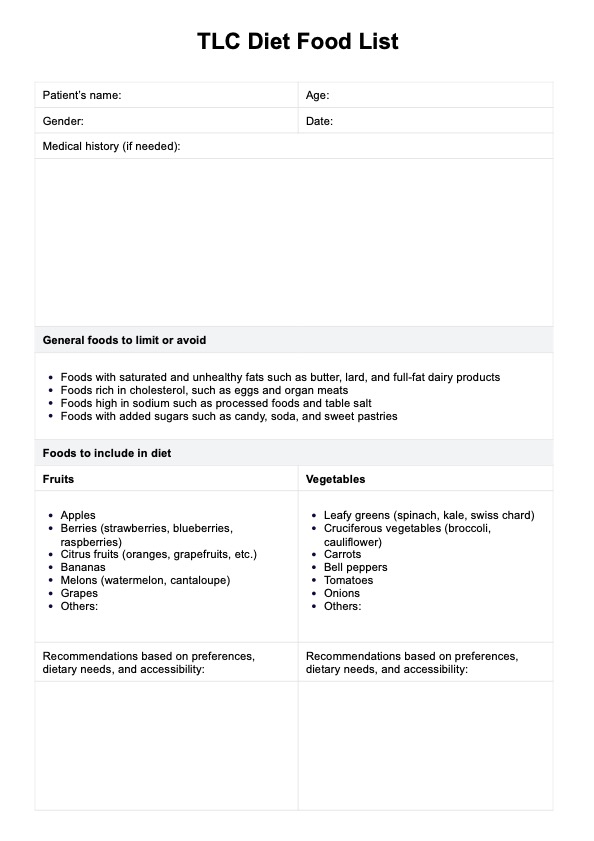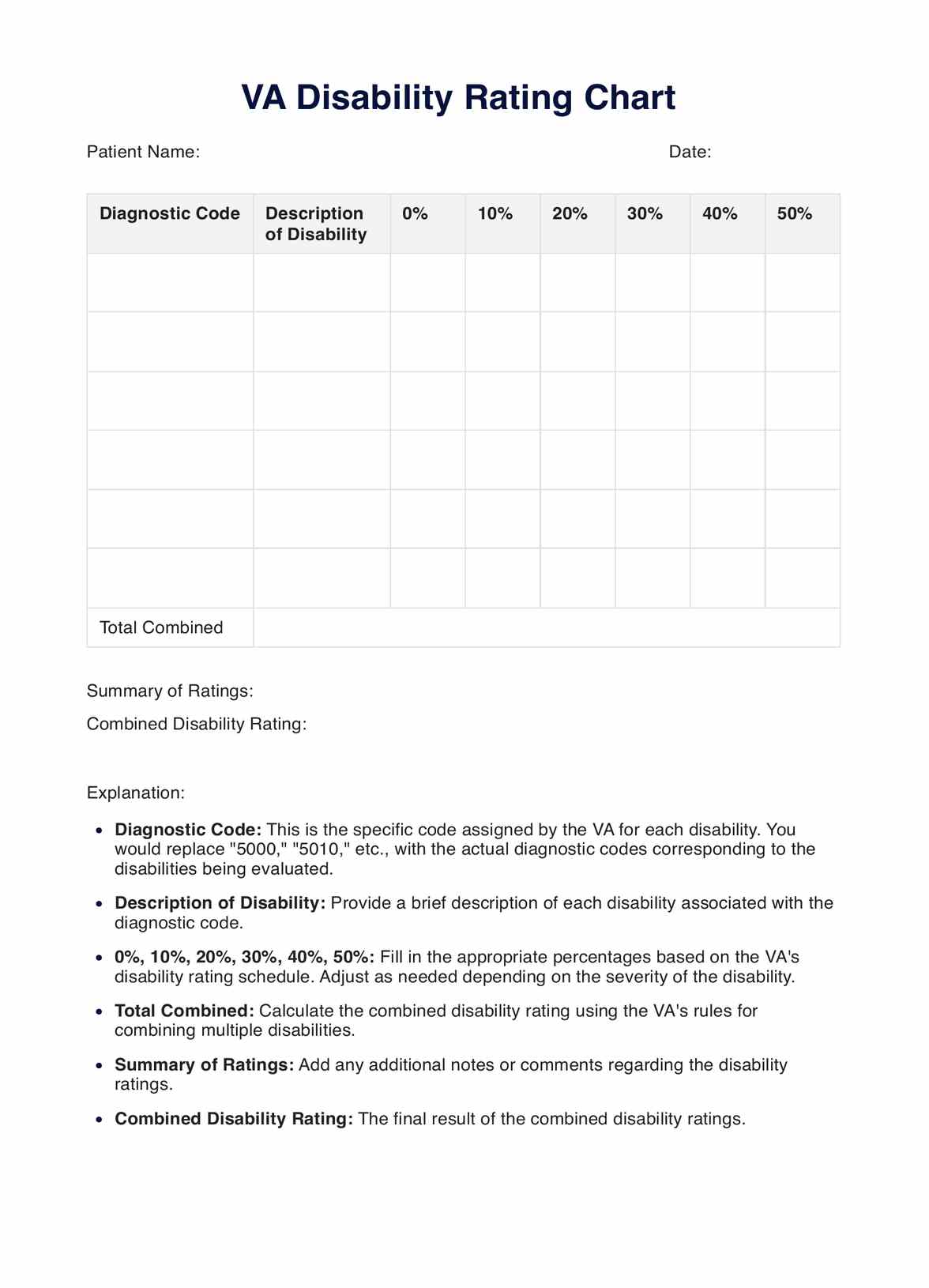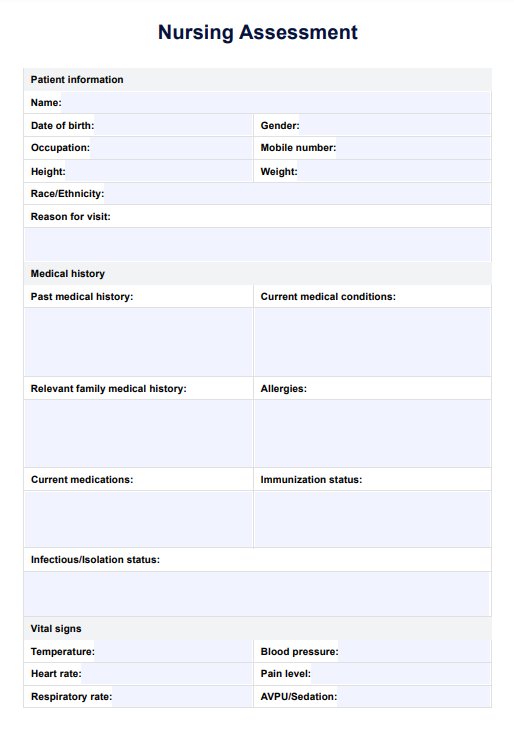30-Day Fruit and Vegetable Diet Plan
Transform your patient's health with our 30-day fruit and vegetable diet to boost wellness and vitality. Start today!


What is a 30-Day Fruit and Vegetable Diet Plan?
The 30-Day Fruit and Vegetable Diet Plan offers a nutritionally rich approach to improving health and achieving weight loss goals. This vegetarian and vegan diet plan emphasizes nutrient-dense foods, incorporating a variety of fruits, vegetables, and plant-based options.
Designed for both health benefits and weight loss, this plant-based diet focuses on balanced, high-protein vegetarian sources, including green beans, zucchini noodles, and green smoothies. It prioritizes minimally processed and whole foods to promote overall wellness.
This healthy diet also offers flexibility, accommodating various eating habits while promoting mindful choices. Consultations with certified sports nutritionists ensure that the plan is balanced and supports healthy weight management.
Carepatron has created a simple 30-Day Fruit and Vegetable Diet Plan to help dietitians tailor their clients' needs. This template makes it easier to document meals for each day so individuals can track their intake and progress over the course of 30 days.
30-Day Fruit and Vegetable Diet Plan Template
30-Day Fruit and Vegetable Diet Plan Example
How does 30-Day Fruit and Vegetable Diet Plan template work?
Our 30-Day Fruit and Vegetable Diet Plan template is designed to help your client kickstart a healthy lifestyle by incorporating more fruits and vegetables into their daily meals. Here's how to use the template:
Step 1: Download the resource
Begin by clicking "Use Template" to start utilizing the document via the Carepatron app. You an also click on the "Download" button to get a PDF copy of the 30-Day Fruit and Vegetable Diet Plan template.
Step 2: Fill in the template
Write your patient's name, age, height, weight and goals to start personalizing the plan. Then, complete the sections allotted for each week to outline the recommended fruits and vegetables for breakfast, lunch, dinner, and snacks.
Step 3: Use the sample plan
Our template also includes a sample meal plan you can use as a reference for creating your client's customized diet plan. Adjust the portions and ingredients based on their dietary restrictions, preferences or goals.
Step 4: Add recommendations
As a health professional, you can also provide additional tips, suggestions or guidelines on how to incorporate more fruits and vegetables into their meals. This could include meal prep ideas, recipe suggestions, or ways to make healthier versions of their favorite dishes.
Step 5: Adjust as needed
Every person's dietary needs and preferences are different, so it's important to adjust the plan accordingly. Monitor your client's progress and make changes as needed to ensure they are on track toward meeting their goals.
Food to include in the diet plan
Individual preference may vary, but generally incorporating a variety of colorful fruits and vegetables into a daily diet is recommended. Some great options include:
Fruits
Frutis are a vital part of a healthy diet, offering a variety of fresh options such as apples, berries, oranges, and bananas. For those who enjoy smoothies, frozen fruit is a convenient choice, while lime juice can be used to add a refreshing burst of flavor to various dishes.
Vegetables
Leafy greens like spinach, kale, and lettuce provide essential nutrients, while cruciferous vegetables such as broccoli, cauliflower, and Brussels sprouts offer unique health benefits. For a pasta alternative, zucchini noodles are a great choice, and celery sticks make for a crunchy, healthy snack. Additionally, sweet potatoes add fiber and vitamins, making them a valuable addition to your diet.
Whole grains
Whole grains, such as brown rice, quinoa, and oats, are excellent sources of fiber and provide sustained energy, making them essential for a balanced diet. Incorporating whole-grain bread and pasta in moderation can further enhance nutritional intake while supporting overall health and wellness.
Proteins
Protein sources include plant-based options such as beans, lentils, and chickpeas, which provide vital nutrients for a healthy diet. Nuts and seeds, including almonds, walnuts, chia seeds, and sesame seeds, are also excellent sources of protein. Additionally, tofu and tempeh serve as great meat alternatives, offering versatility and nutrition for those seeking to reduce their meat consumption.
Healthy fats
Healthy fats are essential for a balanced diet and can be easily incorporated into meals. Olive oil is a great choice for cooking and salad dressings, while coconut oil can be used in moderation for added flavor and health benefits. Additionally, avocados are an excellent source of monounsaturated fats, making them a nutritious addition to various dishes.
Beverages
Beverages play a crucial role in hydration, with water being the primary source. For added variety and hydration, herbal teas, and fruit juice offer a delightful alternative, making them a great choice to complement your client's daily fluid intake.
Tips for using this template
Our 30-Day Fruit and Vegetable Diet Plan template is a great tool for crafting a customize diet plan for your clients. Here are a few tips to help you make the most out of this template:
- Customize it for each client: While this template provides a general guideline, it is important to tailor the plan to fit each individual's needs and preferences. Consider their food allergies, dietary restrictions, and taste preferences when creating their personalized plan.
- Include variety: Variety is key when it comes to maintaining a healthy diet. Make sure to include a diverse range of fruits and vegetables in your client's meal plan. This will not only prevent boredom with repetitive meals but also provide them with a range of nutrients.
- Introduce new foods gradually: It can be overwhelming for some people to suddenly switch to a completely new diet. Gradually introducing new fruits and vegetables can make it easier for your clients to adjust and develop a taste for them.
- Encourage water intake: Hydration is essential for overall health, especially when consuming a diet high in fruits and vegetables. Encourage your clients to drink plenty of water throughout the day to stay hydrated.
- Consider meal prep: Planning ahead and prepping meals can save time and make it easier for your clients to stick to their plan. Encourage them to batch cook and prepare snacks in advance for busy days.
- Provide resources: Along with this template, provide your clients with additional resources such as recipes, grocery lists, and tips for eating out on a healthy diet. This will not only support their journey but also give them the tools to continue their healthy eating habits in the long run.
- Check-in regularly: It is important to check-in with your clients regularly to assess progress and make necessary adjustments to their plan. This will also show that you are invested in their journey and provide accountability for both of you.
In addition, it is important to remind your clients that a healthy diet is just one aspect of overall health. Incorporating regular physical activity and managing stress levels are also crucial for maintaining a balanced lifestyle. Encourage your clients to find activities they enjoy and remind them to prioritize self-care.
Benefits of the 30-Day Fruit and Vegetable Diet Plan
The 30-Day Fruit and Vegetable Diet Plan offers numerous benefits that can significantly impact overall health and well-being. Here are five key advantages of adhering to this plan:
Weight loss
One of the primary benefits of this diet plan is its potential for weight loss. By emphasizing whole, nutrient-dense foods and minimizing processed and calorie-dense options, individuals can create a calorie deficit, leading to weight loss.
Improved heart health
A diet rich in fruits, vegetables, whole grains, and plant-based protein sources has been linked to a lower risk of cardiovascular diseases. The high fiber content of these foods can help lower cholesterol levels and improve heart health. Additionally, the absence of saturated fats in animal products can further promote cardiovascular health.
Enhanced nutrient intake
Fruits and vegetables are packed with essential vitamins, minerals, and antioxidants that support overall health. By following this diet plan, individuals can ensure they meet their daily nutrient needs with a variety of plant foods, promoting optimal functioning of the body systems. Incorporating a variety of colorful fruits and vegetables provides a broad spectrum of nutrients, helping to prevent deficiencies and support immune function.
Increased energy levels
The nutrient-rich nature of the foods included in this plan can lead to increased energy levels, stable blood sugar, and improved vitality. Whole foods provide a sustained energy source, preventing energy crashes often associated with processed foods with added sugars and refined carbohydrates.
Digestive health
The high fiber content of fruits, vegetables, and whole grains supports digestive health by promoting regularity and preventing constipation. Fiber also acts as a prebiotic, nourishing beneficial gut bacteria and supporting a healthy gut microbiome.
Commonly asked questions
The diet plan can be customized based on individual preferences, dietary restrictions, and nutritional needs. It's essential to consult with a healthcare professional or nutritionist to ensure that any modifications meet your specific requirements while providing adequate nutrition.
While weight loss results may vary depending on factors such as metabolism, activity level, and starting weight, many people experience weight loss on the 30-Day Fruit and Vegetable Diet Plan. By focusing on nutrient-dense, low-calorie foods and reducing intake of processed foods and added sugars, participants may create a calorie deficit conducive to weight loss.
The diet plan may offer numerous health benefits, including improved heart health, better digestion, increased energy levels, and reduced risk of chronic diseases such as diabetes, hypertension, and certain cancers. The high intake of fruits and vegetables provides essential vitamins, minerals, and antioxidants that support overall health and well-being.


